Did you know that up to 30% of energy loss in UK homes is due to inefficient heating systems? Retrofitting underfloor heating could lower bills and increase property value. If you want to experience modern comfort while making your home more energy-efficient, it's time to explore how retrofit underfloor heating can transform your property. In this complete guide, you'll learn everything from why it's worth considering, to step-by-step installation and expert tips for getting the most from your investment.
Why Retrofit Underfloor Heating? The Case for Modern Comfort and Value
"Did you know that up to 30% of energy loss in UK homes is due to inefficient heating systems? Retrofitting underfloor heating could lower bills and increase property value." – Peak Underfloor Heating Ltd

The Growing Demand for Retrofit Underfloor Heating in Existing Floors
Across the UK, homeowners are making the switch to retrofit underfloor heating as they look to improve their comfort and energy use without full property renovations. Unlike traditional radiators, these systems are designed to be installed beneath existing floors - from wooden boards to tiles - making them ideal for both older homes and recent builds. Property owners see the benefits in reduced heat loss, lower running costs, and a healthier, draft-free environment. The trend is only accelerating as awareness spreads about how much more effectively underfloor heat can warm a room compared to ageing radiator-based systems. If you’re planning a renovation project or simply want to upgrade your living space, retrofitting underfloor heating is a smart, future-proof investment.
Key Benefits of Retrofitting Underfloor Heating vs. Traditional Heating Systems
Switching to retrofit underfloor heating means more than just warm toes; it translates to significant energy efficiency gains, evenly distributed heat, and space-saving benefits. Unlike radiator systems, which create uneven hot spots and take up precious wall space, underfloor heating system spreads warmth evenly across the floor covering, making entire rooms comfortable from the ground up. This lowers the required air temperature for the same comfort, leading to reduced running costs and a smaller carbon footprint. Other advantages include better compatibility with renewable heat sources like heat pumps and much-improved property aesthetics - no more bulky radiators to work around when decorating or furnishing. In summary, upgrading to underfloor heating modernises your home while increasing long-term value.
Common Myths about Retrofit Underfloor Heating—Debunked
Many believe that retrofit underfloor heating is only suitable for new build properties or will significantly raise your floor height, but modern low profile and slimline overlay system solutions mean that most existing homes can enjoy a seamless, minimally disruptive installation.
Concerns about installation cost and timeframes are often overstated as well - rapid advances in underfloor heating systems mean even DIY enthusiasts can complete smaller projects with guidance, though professional installation is recommended for best results. Myths about running costs and system maintenance are quickly dispelled when you see the potential energy savings and available smart control technology.
What You'll Learn in This Complete Guide
Step-by-step process for retrofit underfloor heating installation
Critical considerations before starting a retrofit underfloor heating project
Cost breakdowns, timeframes, and choices of underfloor heating systems
Expert advice on energy efficiency, floor coverings, and solutions for different home layouts
Understanding Retrofit Underfloor Heating: A Quick Overview
What Is Retrofit Underfloor Heating?
Retrofit underfloor heating is an upgrade that brings energy-efficient comfort to homes of any age. These systems are specifically engineered to work with existing floors, unlike traditional systems that are often fitted during major renovations or new construction. They consist of either electric underfloor heating mats or water-based (hydronic) pipes that fit snugly beneath your current floor covering, providing gentle and even warmth. The installation process is thoughtfully designed to minimise disruption while maximising efficiency, making retrofit options increasingly popular among UK homeowners looking to modernise without starting from scratch.
Key Components of a Retrofit Underfloor Heating System
A typical retrofit underfloor heating system involves several essential components: the heating element (pipes for water-based, or mats/cables for electric), insulation boards to prevent heat loss downwards, a control system (thermostat or smart panel), and an appropriate floor covering above (such as tile, wood, or carpet). In water-based systems, a connection to your existing heat source—like a gas boiler or heat pump—is crucial, while electric systems simply need a compatible power circuit. Modern solutions also include low profile and overlay systems that keep changes to floor height minimal, fitting seamlessly into spaces where traditional setups would be impossible.
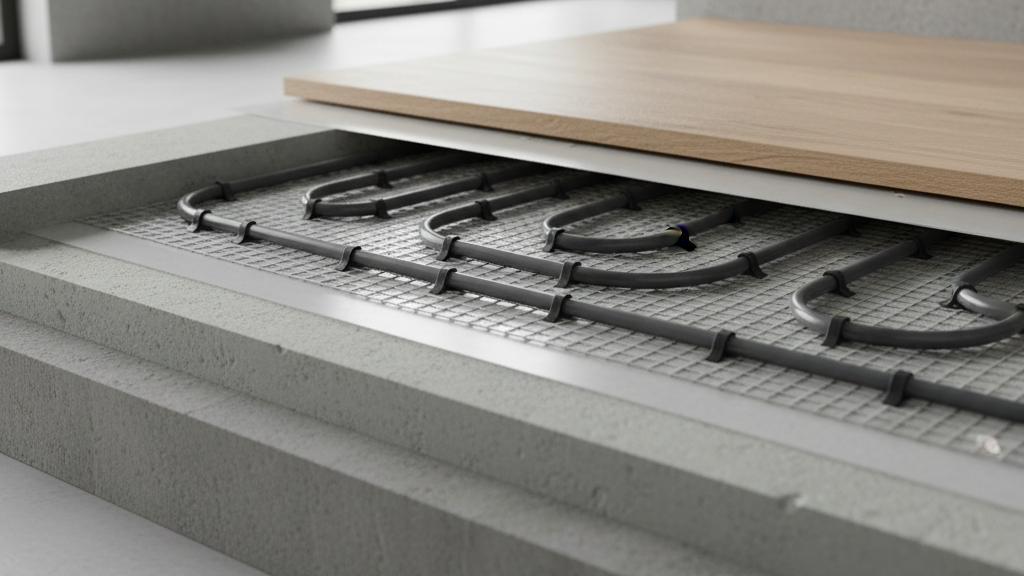
How Underfloor Heat Works in Existing Floors
With retrofit underfloor heating, warmth is generated either by circulating warm water through embedded pipes or passing electricity through heated mats. Heat travels upward in a gentle, radiant fashion, turning the entire floor covering into a source of comfort—rather than just the air. Because the warmth is distributed across the room's floor level, you’ll notice fewer chilly spots and consistent temperatures. This means no more cold draughts or overheating, creating a healthier and more inviting indoor climate. Importantly, the energy efficiency of underfloor heat is significantly higher than radiators, thanks to lower running temperatures and enhanced heat retention with the correct insulation.
Choosing the Right Underfloor Heating System for Your Retrofit
Electric Underfloor Heating vs. Water-Based UFH Systems
When selecting a retrofit underfloor heating system, you’ll encounter two main types: electric underfloor heating (also called dry systems) and water-based (hydronic) UFH systems. Electric solutions are easier and quicker to install, making them popular for single rooms or DIY projects. They consist of electric mats or cables laid directly beneath the existing floor covering, and are ideal for limited spaces where raising the floor level is not an option. On the other hand, water-based systems circulate warm water from your heat source through a network of pipes under the floor. While installation is more involved, these offer outstanding long-term energy efficiency and lower running costs for large or whole-home applications. Your choice will depend on your project, budget, and property type.
When to Opt for Low Profile and Slimline Retrofit Underfloor Heating
If you're concerned about raising floor height or disrupting existing floors, low profile and slimline systems are a game-changer. These innovative overlay systems feature ultra-thin designs, often just 15–20mm in height build, allowing them to be fitted over existing subfloors without the need for extensive or messy work. Particularly suitable for renovation projects where maintaining original door heights and transitions is critical, low profile systems make retrofitting underfloor heating possible in nearly every type of UK property. Whether you’re dealing with solid wood boards or newer engineered floors, there's a retrofit underfloor heating solution for you.
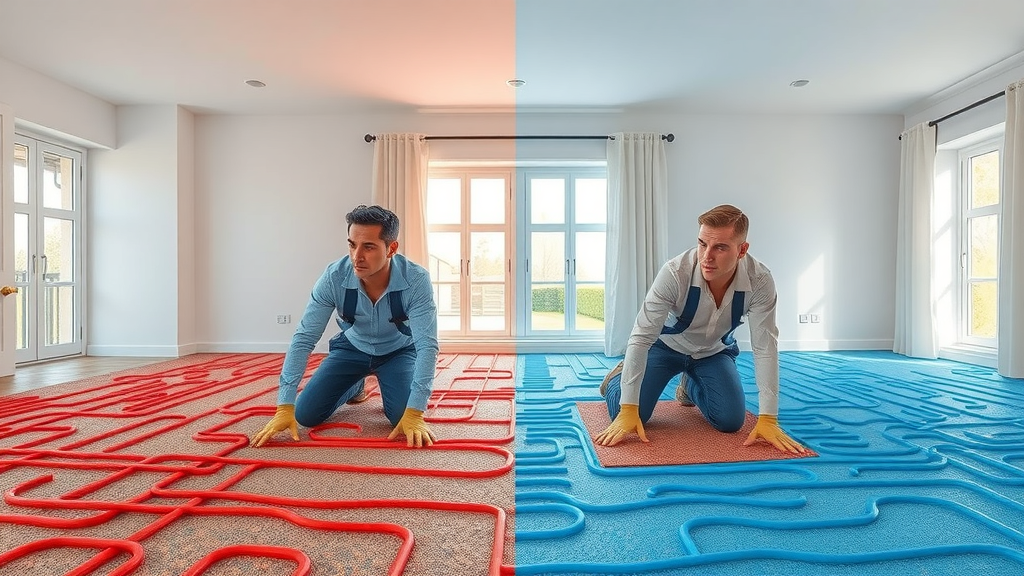
Adapting Your Heating System to Different Floor Levels and Floor Coverings
Every home is unique, from its construction age to the materials used in floor coverings and how many levels it has. Some retrofit systems are specifically designed for upper storeys or suspended floors, while others offer robust performance for ground-floor installations. You’ll want to match the heating system to your home’s needs: for example, tiles conduct and retain heat exceptionally well, while carpets may need special consideration to avoid heat loss. The best approach often combines low profile water systems for main living areas and electric underfloor heating in bathrooms or lofts where accessibility is more limited. Discuss your requirements with a pro to find the best combination for comfort and longevity.
Electric vs. Water-Based Retrofit Underfloor Heating Systems
Feature |
Electric Underfloor Heating |
Water-Based UFH System |
|---|---|---|
Install Cost |
£600–£900 per average room |
£1,200–£2,500 per average room |
Efficiency |
Good (best for small rooms) |
Excellent (ideal for large areas) |
Running Cost |
Higher (electricity cost) |
Lower (especially with heat pump) |
Floor Height Change |
Minimal to none |
Minimal with low profile overlay systems |
Ideal Use Case |
Bathrooms, kitchens, single rooms |
Whole-house, open-plan spaces |
Step-by-Step Guide: How to Retrofit Underfloor Heating in an Existing Home
Assessing your home: Is retrofit underfloor heating suitable?
Planning and measuring: Understand your floor structure and room layout
Selecting and sourcing: Choose the right underfloor heating system for your project
Preparing the floor: Address insulation, anticipated floor level changes, and check the sub-floor for soundness
Installation: Lay underfloor heating pipes or electric mats according to specification
Connecting: Link the system to the heat source and commission the heating system according to safety standards
Compatibility check: Ensure the new system works with tile, wood, or carpet floor coverings for best results
Final checks and maintenance: Activate the system and get expert maintenance advice for long-lasting performance
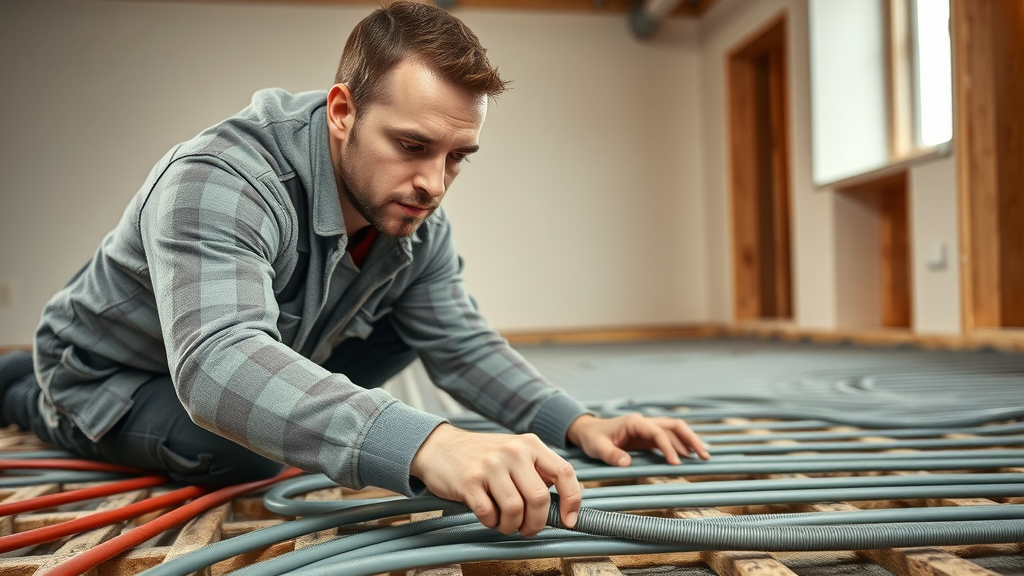
Video Walkthrough: Installing or Retrofitting Underfloor Heating Step-by-Step
Important Considerations Before Retrofitting Underfloor Heating
Addressing Floor Height and Floor Level Impacts
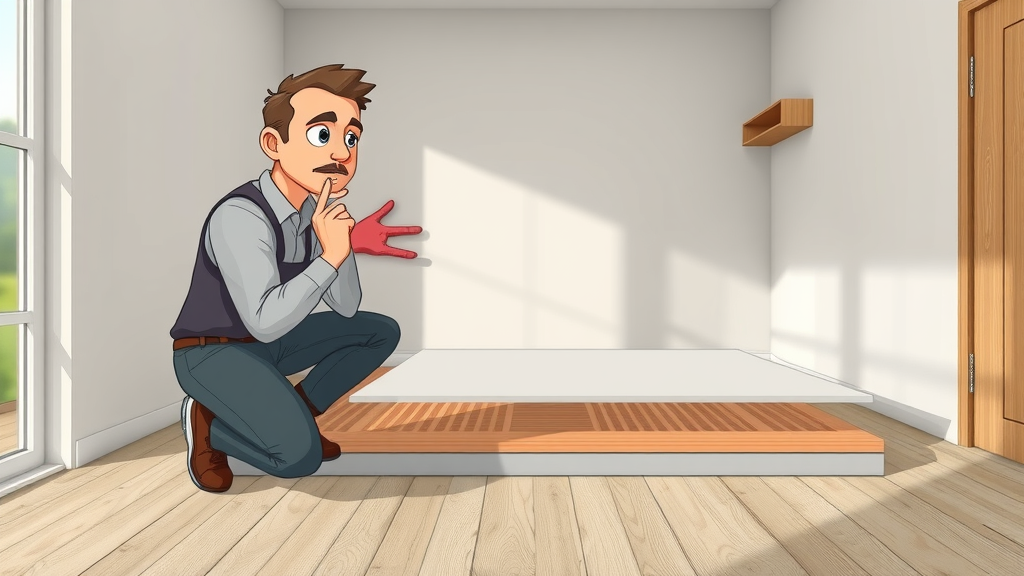
One of the main questions homeowners face is whether retrofit underfloor heating will significantly alter their floor height and disrupt door thresholds or skirting. Thankfully, advances in low profile overlay systems have minimised these issues—most options add as little as 15mm to your existing floor level, rarely more than a thick carpet underlay. It’s critical, however, to account for the height build when planning transitions between rooms, ensuring smooth movement and a flawless finish. For peace of mind, a professional assessment is recommended, as some floor types do better than others with these innovative solutions.
Achieving Optimal Energy Efficiency with Retrofitting Underfloor Heating
Optimal energy efficiency begins with good insulation and the right control systems. If your home has poor insulation or lacks an efficient heat source (such as a condensing boiler or a heat pump), you might not realise the full savings potential. Before installing, it’s wise to upgrade loft and wall insulation and opt for smart thermostats that let you schedule and regulate zones. Properly installed underfloor heating systems can cut running costs by 20–40% compared to traditional radiators, especially when paired with renewable energy sources. Thoughtful planning means you’ll enjoy comfort and cost savings for years to come.
Anticipated Costs, Timeframes & Potential Disruptions
Budgeting for retrofit underfloor heating is straightforward, but the type of system and size of your space have major impacts. Installation costs for electric systems are typically lower and suited for quick turnarounds (often 1–2 days per room), while water-based systems take longer due to plumbing needs but offer greater savings over the long term.
Expect some disruption: floors must be cleared, minor joinery may be required, and drying times for any screeds or adhesives need to be respected. However, most reputable installers use overlay systems that minimize downtime and keep dust and mess to a minimum. Always account for the total duration and plan your renovation project accordingly to keep stress low and results high.
Professional vs. DIY: Which Route Is Best for Your Project?
While skilled DIYers might be tempted to install certain electric systems themselves, most retrofit underfloor heating projects benefit from professional expertise. A pro can ensure the system is tailored to your space, meets British standards for safety, and delivers reliable, even heat without risk of damaging existing floors or causing costly leaks. For water-based systems, specialist help is almost always required due to work with plumbing and connections to the heat source. Choosing a certified installer also provides a warranty and ongoing support. For advice, call us at Peak Underfloor Heating Ltd—we handle everything from planning to post-installation care.
Estimated Retrofit Underfloor Heating Costs by Room Type and System
Room Type |
Electric UFH |
Water-Based UFH |
|---|---|---|
Bathroom (5m²) |
£450–£650 |
£750–£1,300 |
Kitchen (15m²) |
£850–£1,400 |
£1,700–£2,800 |
Living Room (30m²) |
£1,800–£2,400 |
£2,900–£4,200 |
"Retrofit underfloor heating adds luxury, improves efficiency, and frequently pays for itself through increased home value."—Ed Serrell, CEO
Retrofitting Underfloor Heating: Common Challenges and Smart Solutions
Working around existing floor coverings and structural limitations
Maintaining optimal heating with low profile retrofit underfloor heating systems
Ensuring your heating system is future-proof and energy efficient
Addressing compatibility with renewable heat sources and smart thermostats
Installing retrofit underfloor heating is not without hurdles. You might encounter unexpected structural quirks, legacy floor coverings, or limited ceiling heights. The solution often lies in choosing low profile systems, tailor-made overlays, or adjusting the heating system zones. When integrating with future technologies like heat pumps and smart controls, selecting adaptable systems today ensures your investment pays off long-term. Don't forget to consult your installer about levelling compound usage on uneven subfloors and how best to avoid heat loss through insulation upgrades.
Expert Tips to Maximise Efficiency and Comfort from Your Retrofit Underfloor Heating
Selecting Smart Controls and Thermostats for Underfloor Heating

Smart controls are at the heart of a modern underfloor heating system. Digital thermostats with WiFi connectivity allow remote temperature adjustments and scheduling, ensuring you only use energy when and where it’s needed. Zoning controls let you fine-tune different areas of your home, optimising comfort and energy efficiency at every floor level. Integration with other home automation, such as voice controls or smart meters, further boosts performance and convenience. When you invest in a smart thermostat, you’re making ongoing running cost reductions a reality.
Insulation and Floor Covering Recommendations
Maximising the benefits of retrofit underfloor heating relies on great insulation. High-quality insulation prevents heat loss into the subfloor, directing every watt into warming your living space. Depending on your floor covering, you might need denser insulation panels or vapour barriers. Tile and stone conduct heat best, wood performs well with proper installation, and carpet demands low-tog underlay for efficient transfer. Always ask about insulation standards during planning, and consider updating older floors for lasting performance.
Reducing Running Costs While Enhancing Comfort
Lowering running costs comes down to a combination of smart design and everyday habits. Schedule your underfloor heating system to align with your routine, reducing energy use during unoccupied periods. Program different floor levels or rooms with separate controls for bespoke comfort and even greater savings. Systematic maintenance—such as periodic checks on thermostat calibration and insulation integrity—is key. Switching to a heat pump or solar support can further drive down the cost of keeping your home wonderfully cosy, all year round.
Best Practices When Retrofitting Underfloor Heating in Period Properties [Watch on Peak Underfloor Heating's Youtube Channel]
People Also Ask about Retrofit Underfloor Heating
Is retrofit underfloor heating any good?
Absolutely! Retrofit underfloor heating delivers even, luxurious warmth, reduces heat loss, and can be tailored to almost any floor covering or existing floor structure. Thanks to modern low profile overlay systems, the installation is usually quick, minimally disruptive, and delivers results far superior to traditional radiators in terms of comfort and energy efficiency.
How much does it cost to retrofit underfloor heating?
The cost depends on the system (electric or water) and the size of your space. Typically, electric systems cost between £450–£1,400 per room, while water-based systems range from £1,000–£4,200+ for larger rooms. These costs reflect material, preparation, and installation, with whole-home upgrades eligible for multi-room discounts. Professional installation ensures maximum efficiency and value.
Can underfloor heating be retro fitted?
Yes, underfloor heating can be retrofit in most existing homes. Advances in low profile and overlay systems make it possible to fit these solutions over or beneath almost any existing floor, including timber, concrete, and screeded bases. The minimal increase in floor height means doors and skirting are rarely affected.
How thick is retrofit underfloor heating?
Modern retrofit underfloor heating adds as little as 15–20mm to a floor level, especially with slimline overlay solutions. Some electric mat systems are even thinner, fitting directly beneath new or existing floor coverings. Always consult your installer for the lowest profile available for your property.
More Frequently Asked Questions: Retrofit Underfloor Heating
What is the lifespan of retrofit underfloor heating? A well-installed system typically lasts 20–50 years, with water-based systems often outlasting electric due to fewer replaceable parts.
Which floors are most suitable for retrofitting? Concrete slabs, suspended timber, and even some floating floors can all accommodate retrofit underfloor heating—low profile systems are ideal for most scenarios.
Will retrofit underfloor heating affect my home’s resale value? Yes, positively. Modern heating solutions increase property appeal and may boost your home’s market value.
Is there disruption to daily life during installation? Minimal, especially with professional teams using overlay systems. Expect each room to be disrupted for 1–3 days, depending on project size.
Can it integrate with renewable heat sources (like heat pumps)? Absolutely. Water-based retrofit systems are especially well-suited for coupling with heat pumps for maximum energy efficiency.
Key Takeaways: Retrofit Underfloor Heating in Existing Homes
Retrofit underfloor heating is cost-effective, energy-efficient, and suitable for most existing homes.
Low profile options overcome floor level challenges and fit beneath most floor coverings.
Choose professional installation for peace of mind and the best results.
Conclusion: Should You Retrofit Underfloor Heating in Your Home?
If comfort, efficiency, and higher property value matter to you, retrofitting underfloor heating is a smart and future-ready upgrade for almost any home.
Ready to Transform Your Home with Retrofit Underfloor Heating?
Discover how retrofit underfloor heating can change your home’s comfort and efficiency forever. Contact Peak Underfloor Heating Ltd today to arrange a free consultation and see why so many UK homeowners are making the switch.
Sources
Energy Saving Trust – https://www.energysavingtrust.org.uk/advice/underfloor-heating/
Peak Underfloor Heating Ltd – https://www.peakunderfloorheating.co.uk/
Retrofitting underfloor heating in an existing home offers numerous benefits, including enhanced comfort, improved energy efficiency, and increased property value.
 Add Row
Add Row  Add
Add 







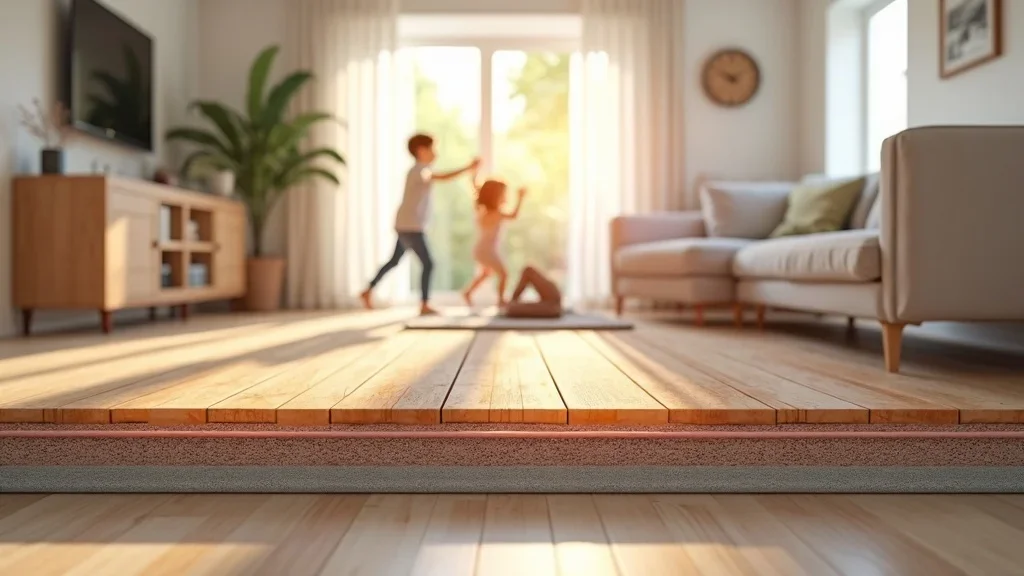

Write A Comment